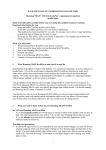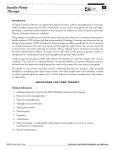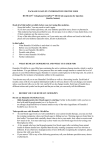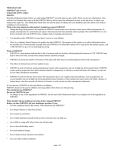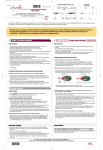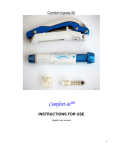Download FDA Approves Updates to Lilly`s Humalog® (insulin lispro injection
Transcript
FDA Approves Updates to Lilly's Humalog® (insulin lispro injection [rDNA origin]) Label Update for Insulin Pump Use Provides an Additional Option for Children With Type 1 Diabetes and Extends Amount of Time People Can Use and Store Humalog Insulin in Their Pumps INDIANAPOLIS, June 8, 2011 /PRNewswire/ -- Eli Lilly and Company (NYSE: LLY) today announced that the U.S. Food and Drug Administration (FDA) approved the company's supplemental new drug application (sNDA) with the following updates to the Humalog label: ● ● ● continuous insulin infusion pump therapy in children 4 years of age and over with type 1 diabetes extension of the time-in-use in the external pump reservoir to a maximum of seven days; and extension of the time-in-use of the infusion set and of the infusion set subcutaneous insertion site to a maximum of three days. Based on the updated label, people with type 1 diabetes using Humalog for pump therapy can use the insulin in the pump reservoir for up to seven days and should change the infusion set and infusion set insertion site at least every three days. The previous label indicated that Humalog in the external insulin pump reservoir should be replaced and a new infusion site selected every 48 hours or less. Humalog, which contains 100 units per mL, is used to treat people with diabetes for the control of high blood sugar. Humalog should not be taken by someone with low blood sugar (hypoglycemia) or by someone who is allergic to insulin lispro or any of the ingredients in Humalog. Humalog is recommended for use in pump systems indicated for continuous delivery of fast-acting insulin. All people treated with insulin should closely monitor their blood glucose and make changes to their insulin regimen cautiously and only under medical supervision. See Important Safety Information below, and additional information about Humalog is available at www.humalog.com. Insulin pumps deliver insulin 24 hours a day through a catheter placed under the skin. Rapid-acting insulin is delivered continuously to help keep blood glucose levels in a specified range between meals, after meals and overnight. "Insulin pumps can be an additional option for people using rapid-acting insulin and allow people to manage their type 1 diabetes around their lifestyle," said Dana Hardin, MD, a pediatric endocrinologist and clinical research physician at Lilly. "These Humalog label updates reflect Lilly Diabetes' commitment to providing people with personalized solutions that meet their everyday needs." In coordination with these label updates, the package insert for Humalog also was updated in accordance with the Physician's Labeling Rule (PLR) format. Important Safety Information for Humalog What is the most important information I should know about Humalog®? ● ● ● Do not change the insulin you use without talking to your healthcare provider. Any change in insulin strength, manufacturer, or type may need a change in the dose you are using. Doses of oral antidiabetic medicines may also need to change if your insulin is changed. You must test your blood sugar levels while using an insulin such as Humalog. Your healthcare provider will tell you how often you should test your blood sugar level. When used in a pump, do not mix Humalog with any other insulin or liquid. Who should not take Humalog? Do not take Humalog if: ● your blood sugar is too low (hypoglycemia). ● you are allergic to insulin lispro or any of the ingredients in Humalog. What should I tell my healthcare providers before using Humalog? Tell all of your healthcare providers: ● ● ● about all of your medical conditions, including liver or kidney problems. if you are pregnant or breastfeeding. Humalog has not been studied in pregnant or nursing women. about all the medicines you take, including prescription and non-prescription medicines, vitamins, and herbal supplements. Your Humalog dose may need to change if you take other medicines because they may: ❍ change your risk for low blood sugar (hypoglycemia) or high blood sugar (hyperglycemia). ❍ keep you from having symptoms when your blood sugar is low. How should I use Humalog? ● ● ● ● ● ● ● ● ● ● ● ● Humalog can be used with a syringe, prefilled pen, reusable pen, or external insulin pump. Read the instructions for use that come with your Humalog product. Your healthcare provider should show you how to inject Humalog before you start taking it. Humalog is a rapid-acting insulin. You should take Humalog within fifteen minutes before eating or right after eating a meal. Only use Humalog that is clear and colorless. If your Humalog is cloudy, colored, or has solid particles or clumps in it, return it to your pharmacy for a replacement. Do not mix Humalog with any type of insulin other than NPH when used with injections by syringe or with any other insulin or liquid when used in a pump. If your doctor recommends diluting Humalog (that is, a smaller number of units of Humalog for a certain amount of liquid), follow your doctor's instructions exactly. Do not use diluted insulin in a pump. Inject Humalog under your skin (subcutaneously) in your upper arm, abdomen (stomach area), thigh (upper leg), or buttocks. Never inject it into a vein or muscle. Change (rotate) your injection site with each dose. If you have type 1 diabetes, you need to take a longer-acting insulin in addition to Humalog (except when using an external insulin pump). If you have type 2 diabetes, you may be taking oral antidiabetic medicines and/or a longer-acting insulin in addition to Humalog. Always make sure that you received the correct type of Humalog from the pharmacy and make sure you inject the correct insulin and dose. If you take too much Humalog, your blood sugar may fall low (hypoglycemia). You can treat mild low blood sugar by drinking or eating a quick source of sugar right away. It is important to treat low blood sugar right away because it could get worse and you could pass out (become unconscious). If you pass out, you will need help from another person or emergency medical services right away, and will need treatment with glucagon injection or treatment at a hospital. If you forget to take your dose of Humalog, your blood sugar may go too high (hyperglycemia). If high blood sugar is not treated it can lead to serious problems, like loss of consciousness (passing out), coma, or even death. Follow your healthcare provider's instructions for treating high blood sugar. Know your symptoms of high blood sugar, which may include increased thirst, frequent urination, drowsiness, loss of appetite, a hard time breathing, fruity smell on the breath, high amounts of sugar and ketones in your urine, nausea, vomiting (throwing up), or stomach pain, or other symptoms. Your insulin dosage may need to change because of illness, stress, other medicines you take, change in diet, or change in physical activity or exercise. What are the possible side effects of Humalog? ● ● ● ● Low blood sugar (hypoglycemia). Symptoms of low blood sugar may include sweating, dizziness or lightheadedness, shakiness, hunger, fast heartbeat, tingling of lips and tongue, trouble concentrating or confusion, blurred vision, slurred speech, anxiety, irritability or mood changes, and headache. Severe low blood sugar can cause unconsciousness (passing out), seizures, and death. Low blood sugar may affect your ability to drive a car or use mechanical equipment, risking injury to yourself or others. Know your symptoms of low blood sugar. Follow your healthcare provider's instructions for treating low blood sugar. Talk to your healthcare providers if low blood sugar is a problem for you. Serious allergic reactions (whole body reaction). Get medical help right away if you develop a rash over your whole body, have trouble breathing, have a fast heartbeat, or are sweating. Reactions at the injection site (local allergic reaction). You may get redness, swelling, and itching at the injection site. If you keep having skin reactions or if they are serious, talk to your healthcare provider. Do not inject insulin into a skin area that is red, swollen, or itchy. ● ● ● Skin thickens or pits at the injection site (lipodystrophy). Do not inject insulin into skin with these types of changes. Other side effects of Humalog include swelling of your hands and feet, low potassium in your blood (hypokalemia), and weight gain. These are not all of the possible side effects from Humalog. Ask your healthcare providers for more information or for medical advice about side effects. You are encouraged to report negative side effects of Prescription drugs to the FDA. Visit www.fda.gov/medwatch or call 1-800FDA-1088. How should I store Humalog? ● ● Store all unopened (unused) Humalog in the original carton in a refrigerator at 36 degrees F to 46 degrees F (2 degrees C to 8 degrees C). Do not freeze. Do not use Humalog if it has been frozen. Keep unopened Humalog in the carton to protect it from light. After starting use (open): ❍ Vials: Keep in the refrigerator or at room temperature below 86 degrees F (30 degrees C) for up to 28 days. Keep vials away from direct heat or light. Throw away an opened vial after 28 days of use, even if there is insulin left in the vial. Unopened vials can be used until the expiration date on the Humalog carton and label, if the medicine has been stored in a refrigerator. ❍ Cartridge and Prefilled Pens: Keep at room temperature below 86 degrees F (30 degrees C) for up to 28 days. Do not store a cartridge or prefilled pen that you are using in the refrigerator. Keep cartridges and prefilled pens away from direct heat or light. A cartridge used in the D-Tron®(1) or D-Tronplus®(1) pump may be used for up to 7 days. Throw away a used cartridge or prefilled pen after 28 days, even if there is insulin left in the cartridge or the pen. What is some general information about the use of Humalog in a pump? ● Humalog in the pump reservoir and the complete external pump infusion set: ❍ The infusion set and infusion site should be changed at least every 3 days or changed more often if you have high blood sugar (hyperglycemia), the pump alarms sounds, or the insulin flow is blocked (occlusion). ❍ The insulin in the reservoir should be changed at least every 7 days even if you have not used all of the insulin. Humalog is available by prescription only. For more information about Humalog, please see the Full Prescribing Information (http://pi.lilly.com/us/humalogpen-pi.pdf) and Patient Prescribing Information (http://pi.lilly.com/us/humalog-pen-ppi.pdf). Please see full user manual that accompanies the pen. (1) D-Tron® and D-Tronplus® are registered trademarks of Roche Diagnostics GmbH. HI CON ISI 24MAY2011 About Eli Lilly and Company Lilly, a leading, innovation-driven corporation, is developing a growing portfolio of pharmaceutical products by applying the latest research from its own worldwide laboratories and from collaborations with eminent scientific organizations. Headquartered in Indianapolis, Ind., Lilly provides answers—through medicines and information—for some of the world's most urgent medical needs. Additional information about Lilly is available at www.lilly.com. About Lilly Diabetes For more than 85 years, Lilly has been a worldwide leader in pioneering industry-leading solutions to support people living with and treating diabetes. Lilly introduced the world's first commercial insulin in 1923 and remains at the forefront of medical and delivery device innovation to manage diabetes. Lilly is also committed to providing solutions beyond therapy -practical tools, education, and support programs to help overcome barriers to success along the diabetes journey. At Lilly, the journeys of each person living with or treating diabetes inspire ours. Humalog® is a registered trademark of Eli Lilly and Company and is available by prescription only. P-LLY (Logo: http://photos.prnewswire.com/prnh/20031219/LLYLOGO ) SOURCE Eli Lilly and Company News Provided by Acquire Media




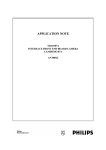

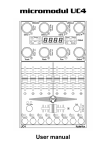

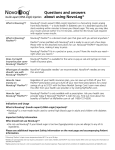
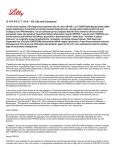
![TEMPLATE No1 [CPMP positive opinion full application]](http://vs1.manualzilla.com/store/data/005681628_1-1a3acb54fcca990dd8c826546eb4788f-150x150.png)
